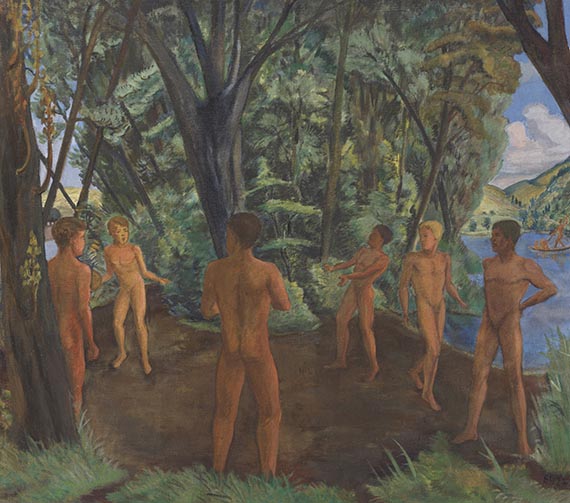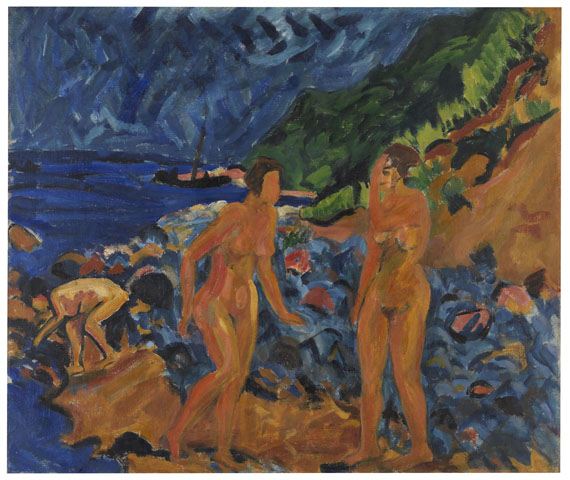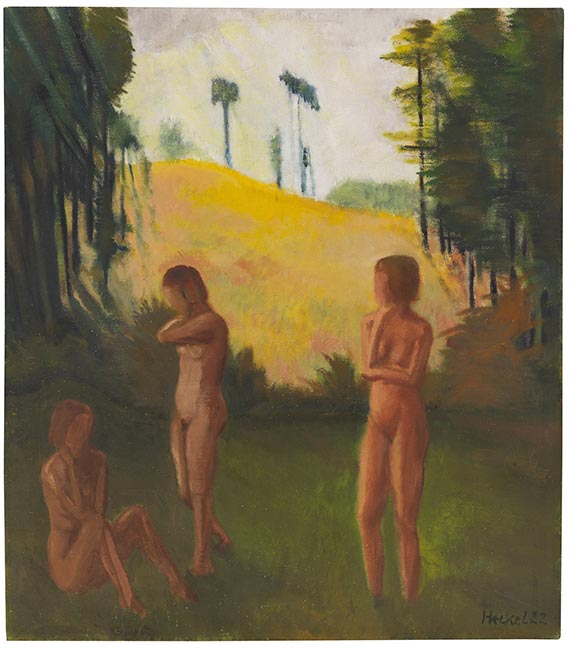Image du cadre
429
Erich Heckel
Ballspielende auf der Maininsel, 1927.
Tempera on canvas
Estimation: € 40,000 / $ 42,800
Ballspielende auf der Maininsel. 1927.
Tempera on canvas.
Lower right monogrammed and date. Verso signed and dated. Stretcher signed and titled "Ballspielende" and inscribed "Tempera nicht firnissen!". 110 x 125 cm (43.3 x 49.2 in).
The work is registered in the Hermann Gerlinger Collection with the number SHG 524a. [CH].
• Extensive exhibition history dating back to 1928.
• The motif-related gouache "Ballspielende" from the same year is in the Brücke-Museum Berlin.
• In the year it was created, Siddi and Erich Heckel spent a long time in Würzburg, where they were guests at the estate of the painter Gertraud Rostosky (1876-1959).
• Heckel's work from the mid-1920s takes up individual stylistic principles of New Objectivity: It shows a more naturalistic painting style and the colors now correspond to reality as seen, in contrast to the expressionist phase.
The work is registered in the Erich Heckel Estate, Hemmenhofen on Lake Constance. We are grateful to Mrs Renate Ebner and Mr Hans Geissler for the kind support in cataloging this lot.
PROVENANCE: Erich Heckel Estate, Hemmenhofen.
Hermann Gerlinger Collection, Würzburg (with the collector's stamp, Lugt 6032, acquired from the above in 2015)).
EXHIBITION: Münchener Neue Secession, XIV. Ausstellung, Glaspalast München, 1928, cat. no. 94.
Wohl: Erich Heckel. Gemälde, Aquarelle, Graphik, Galerie Commeter, Hamburg, February 1931 (stretcher with the gallery label).
Erich Heckel, Galerie Ferdinand Möller, Berlin, November 1930, cat. no. 3.
Erich Heckel. Bilder aus den Jahren 1906-1930, Kunsthütte / Städtisches Museum, Chemnitz, March 18 - April 30, 1931, cat. no. 76.
Erich Heckel, Kestner-Gesellschaft Hanover, October 3 - November 3, 1935, cat. no. 14.
Erich Heckel. Werke aus 4 Jahrzehnten, Galerie der Jugend, Hamburg, from November 1, 1947, cat. no. 15.
Erich Heckel, Kaiser-Wilhelm-Museum Krefeld, April 1948, cat. no. 22.
Erich Heckel. Bilder und Drucke 1911-1949, Kunstverein Freiburg i. Br., 1950; Städtische Kunsthalle, Mannheim, 1950, cat. no. 23.
Erich Heckel, Fränkische Galerie, Nürnberg, January 10 - February 9, 1964; Kunst- und Kunstgewerbeverein, Pforzheim, March 8 - April 5, 1964, cat. no. 17.
Erich Heckel, Galerie Günther Franke, Munich, June 18 - August 25, 1973, cat. no. 19.
Brücke-Museum Berlin (permanent loan 1976-1994).
Erich Heckel, Galerie Henze & Ketterer, Wichtrach 1995.
Kunstmuseum Moritzburg, Halle an der Saale (permanent loan from the Hermann Gerlinger Collection, 2001-2017).
Buchheim Museum, Bernried (permanent loan from the Hermann Gerlinger Collection, 2017-2022).
LITERATURE: Paul Vogt, Erich Heckel, Recklinghausen 1965, no. 1927-4 (illu. in black and white).
Andreas Hüneke, Erich Heckel. Werkverzeichnis der Gemälde, Wandbilder und Skulpturen, vol. II (1919-1964), Munich 2017, p. 151, no. 1927-4 (illu. in colors).
- -
Wilhelm Hausenstein, Münchner Neue Secession 1928, in: Deutsche Kunst und Dekoration: illustr. Monatshefte für moderne Malerei, Plastik, Architektur, Wohnungskunst u. künstlerisches Frauen-Arbeiten, no. 63, 1928/29, illu. on p. 5.
Brücke-Museum (ed.), Katalog der Gemälde, Glasfenster und Skulpturen, Berlin 1983, cat. no. 35.
Janina Dahlmanns, Erich Heckels Werk der Zwischenkriegsjahre 1919-1937, Hamburg 2016, pp. 156f.
Called up: June 8, 2024 - ca. 17.38 h +/- 20 min.
Tempera on canvas.
Lower right monogrammed and date. Verso signed and dated. Stretcher signed and titled "Ballspielende" and inscribed "Tempera nicht firnissen!". 110 x 125 cm (43.3 x 49.2 in).
The work is registered in the Hermann Gerlinger Collection with the number SHG 524a. [CH].
• Extensive exhibition history dating back to 1928.
• The motif-related gouache "Ballspielende" from the same year is in the Brücke-Museum Berlin.
• In the year it was created, Siddi and Erich Heckel spent a long time in Würzburg, where they were guests at the estate of the painter Gertraud Rostosky (1876-1959).
• Heckel's work from the mid-1920s takes up individual stylistic principles of New Objectivity: It shows a more naturalistic painting style and the colors now correspond to reality as seen, in contrast to the expressionist phase.
The work is registered in the Erich Heckel Estate, Hemmenhofen on Lake Constance. We are grateful to Mrs Renate Ebner and Mr Hans Geissler for the kind support in cataloging this lot.
PROVENANCE: Erich Heckel Estate, Hemmenhofen.
Hermann Gerlinger Collection, Würzburg (with the collector's stamp, Lugt 6032, acquired from the above in 2015)).
EXHIBITION: Münchener Neue Secession, XIV. Ausstellung, Glaspalast München, 1928, cat. no. 94.
Wohl: Erich Heckel. Gemälde, Aquarelle, Graphik, Galerie Commeter, Hamburg, February 1931 (stretcher with the gallery label).
Erich Heckel, Galerie Ferdinand Möller, Berlin, November 1930, cat. no. 3.
Erich Heckel. Bilder aus den Jahren 1906-1930, Kunsthütte / Städtisches Museum, Chemnitz, March 18 - April 30, 1931, cat. no. 76.
Erich Heckel, Kestner-Gesellschaft Hanover, October 3 - November 3, 1935, cat. no. 14.
Erich Heckel. Werke aus 4 Jahrzehnten, Galerie der Jugend, Hamburg, from November 1, 1947, cat. no. 15.
Erich Heckel, Kaiser-Wilhelm-Museum Krefeld, April 1948, cat. no. 22.
Erich Heckel. Bilder und Drucke 1911-1949, Kunstverein Freiburg i. Br., 1950; Städtische Kunsthalle, Mannheim, 1950, cat. no. 23.
Erich Heckel, Fränkische Galerie, Nürnberg, January 10 - February 9, 1964; Kunst- und Kunstgewerbeverein, Pforzheim, March 8 - April 5, 1964, cat. no. 17.
Erich Heckel, Galerie Günther Franke, Munich, June 18 - August 25, 1973, cat. no. 19.
Brücke-Museum Berlin (permanent loan 1976-1994).
Erich Heckel, Galerie Henze & Ketterer, Wichtrach 1995.
Kunstmuseum Moritzburg, Halle an der Saale (permanent loan from the Hermann Gerlinger Collection, 2001-2017).
Buchheim Museum, Bernried (permanent loan from the Hermann Gerlinger Collection, 2017-2022).
LITERATURE: Paul Vogt, Erich Heckel, Recklinghausen 1965, no. 1927-4 (illu. in black and white).
Andreas Hüneke, Erich Heckel. Werkverzeichnis der Gemälde, Wandbilder und Skulpturen, vol. II (1919-1964), Munich 2017, p. 151, no. 1927-4 (illu. in colors).
- -
Wilhelm Hausenstein, Münchner Neue Secession 1928, in: Deutsche Kunst und Dekoration: illustr. Monatshefte für moderne Malerei, Plastik, Architektur, Wohnungskunst u. künstlerisches Frauen-Arbeiten, no. 63, 1928/29, illu. on p. 5.
Brücke-Museum (ed.), Katalog der Gemälde, Glasfenster und Skulpturen, Berlin 1983, cat. no. 35.
Janina Dahlmanns, Erich Heckels Werk der Zwischenkriegsjahre 1919-1937, Hamburg 2016, pp. 156f.
Called up: June 8, 2024 - ca. 17.38 h +/- 20 min.
From the late 1920s to the early 1930s, Erich Heckel went on numerous journeys that took him to various parts of Germany and its neighboring countries. The new landscape impressions are reflected in many of his paintings. Heckel now turned to a moderately real world of imagination, which henceforth would dominate his works. Despite the more realistic beginnings, the bathing scene on the Main island near Würzburg is reminiscent of the famous bathers on the Moritzburg lakes made during the "Brücke" period. Würzburg and its surroundings provided the artist with a variety of sources of inspiration, which led to a large number of works in pencil, watercolor and oil. A place that had left a special impression on the Heckels. When they had to give up their small apartment and studio in Osterholz on the Flensburg Fjord in 1939, Siddi Heckel wrote to Gertraud Rostosky: "Now we are looking for a new accommodation, but with the idea of turning it into a permanent place of residence. We are very much considering the area around Würzburg. The choice of landscape is determined by the fact that it is to be a working area for the painter, and Würzburg has proved to be the most suitable." (quoted from Hermann Gerlinger, Katja Schneider (ed.), Die Maler der Brücke. Inventory catalog Hermann Gerlinger Collection, Halle 2005, p. 237) Unfortunately, these plans could not be realized due to the war. The addressee, Gertraud Rostosky, was a painter who had established the commune "Neue Welt" (New World), which the artist couple also visited, on her estate near Würzburg. In the first half of the 20th century, the estate was a meeting place and summer residence for artists, writers and intellectuals that became known as such throughout the region. The summer months from 1922 to 1927 were the heyday of the "Neue Welt". During her training in Paris, Rostosky had become acquainted with the German circle of artists at the "Café du Dôme", which led to numerous visits to Würzburg. The hospitable house increasingly developed into a "haven of the arts", hosting artists such as Otto Modersohn and Alfred Kubin, as well as the publisher and Simplicissimus editor Korfiz Holm and Ernst Rowohlt. [SM]
429
Erich Heckel
Ballspielende auf der Maininsel, 1927.
Tempera on canvas
Estimation: € 40,000 / $ 42,800
Commission, taxes et droit de suite
Cet objet est offert avec imposition régulière ou avec imposition différentielle.
Calcul en cas d'imposition différentielle:
Prix d’adjudication jusqu’à 800 000 euros : frais de vente 32 %.
Des frais de vente de 27% sont facturés sur la partie du prix d’adjudication dépassant 800 000 euros. Ils sont additionnés aux frais de vente dus pour la partie du prix d’adjudication allant jusqu’à 800 000 euros.
Des frais de vente de 22% sont facturés sur la partie du prix d’adjudication dépassant 4 000 000 euros. Ils sont additionnés aux frais de vente dus pour la partie du prix d’adjudication allant jusqu’à 4 000 000 euros.
Le prix de vente inclut la taxe sur la valeur ajoutée, actuellement de 19%.
Calcul en cas d'imposition régulière:
Prix d'adjudication jusqu'à 800 000 € : 27 % de commission majorée de la TVA légale
Prix d'adjudication supérieur à 800 000 € : montants partiels jusqu'à 800 000 € 27 % de commission, montants partiels supérieurs à 800 000 € : 21 % de commission, à chaque fois majorés de la TVA légale.
Prix d'adjudication supérieur à 4.000 000 € : montants partiels supérieurs à 4.000 000 € : 15 % de commission, à chaque fois majorés de la TVA légale.
Si vous souhaitez appliquer l'imposition régulière, merci de bien vouloir le communiquer par écrit avant la facturation.
Calcul en cas de droit de suite:
Pour les œuvres originales d’arts plastiques et de photographie d’artistes vivants ou d’artistes décédés il y a moins de 70 ans, soumises au droit de suite, une rémunération au titre du droit de suite à hauteur des pourcentages indiqués au § 26, al. 2 de la loi allemande sur les droits d’auteur (UrhG) est facturée en sus pour compenser la rémunération liée au droit de suite due par le commissaire-priseur conformément au § 26 UrhG. À ce jour, elle est calculée comme suit :
4 pour cent pour la part du produit de la vente à partir de 400,00 euros et jusqu’à 50 000 euros,
3 pour cent supplémentaires pour la part du produit de la vente entre 50 000,01 et 200 000 euros,
1 pour cent supplémentaire pour la part entre 200 000,01 et 350 000 euros,
0,5 pour cent supplémentaire pour la part entre 350 000,01 et 500 000 euros et
0,25 pour cent supplémentaire pour la part au-delà de 500 000 euros.
Le total de la rémunération au titre du droit de suite pour une revente s’élève au maximum à 12 500 euros.
Calcul en cas d'imposition différentielle:
Prix d’adjudication jusqu’à 800 000 euros : frais de vente 32 %.
Des frais de vente de 27% sont facturés sur la partie du prix d’adjudication dépassant 800 000 euros. Ils sont additionnés aux frais de vente dus pour la partie du prix d’adjudication allant jusqu’à 800 000 euros.
Des frais de vente de 22% sont facturés sur la partie du prix d’adjudication dépassant 4 000 000 euros. Ils sont additionnés aux frais de vente dus pour la partie du prix d’adjudication allant jusqu’à 4 000 000 euros.
Le prix de vente inclut la taxe sur la valeur ajoutée, actuellement de 19%.
Calcul en cas d'imposition régulière:
Prix d'adjudication jusqu'à 800 000 € : 27 % de commission majorée de la TVA légale
Prix d'adjudication supérieur à 800 000 € : montants partiels jusqu'à 800 000 € 27 % de commission, montants partiels supérieurs à 800 000 € : 21 % de commission, à chaque fois majorés de la TVA légale.
Prix d'adjudication supérieur à 4.000 000 € : montants partiels supérieurs à 4.000 000 € : 15 % de commission, à chaque fois majorés de la TVA légale.
Si vous souhaitez appliquer l'imposition régulière, merci de bien vouloir le communiquer par écrit avant la facturation.
Calcul en cas de droit de suite:
Pour les œuvres originales d’arts plastiques et de photographie d’artistes vivants ou d’artistes décédés il y a moins de 70 ans, soumises au droit de suite, une rémunération au titre du droit de suite à hauteur des pourcentages indiqués au § 26, al. 2 de la loi allemande sur les droits d’auteur (UrhG) est facturée en sus pour compenser la rémunération liée au droit de suite due par le commissaire-priseur conformément au § 26 UrhG. À ce jour, elle est calculée comme suit :
4 pour cent pour la part du produit de la vente à partir de 400,00 euros et jusqu’à 50 000 euros,
3 pour cent supplémentaires pour la part du produit de la vente entre 50 000,01 et 200 000 euros,
1 pour cent supplémentaire pour la part entre 200 000,01 et 350 000 euros,
0,5 pour cent supplémentaire pour la part entre 350 000,01 et 500 000 euros et
0,25 pour cent supplémentaire pour la part au-delà de 500 000 euros.
Le total de la rémunération au titre du droit de suite pour une revente s’élève au maximum à 12 500 euros.




 Lot 429
Lot 429 

